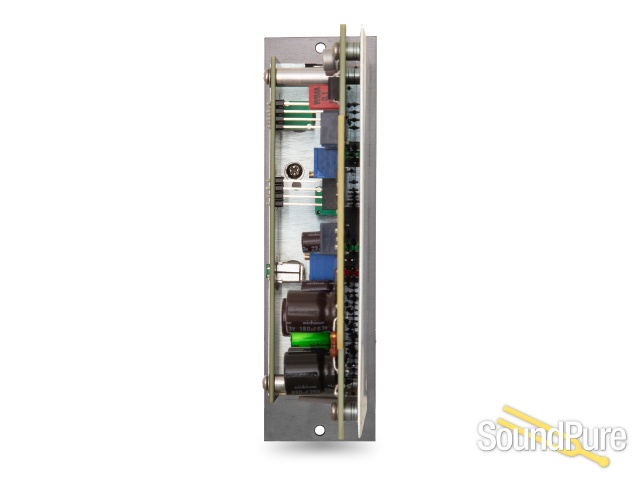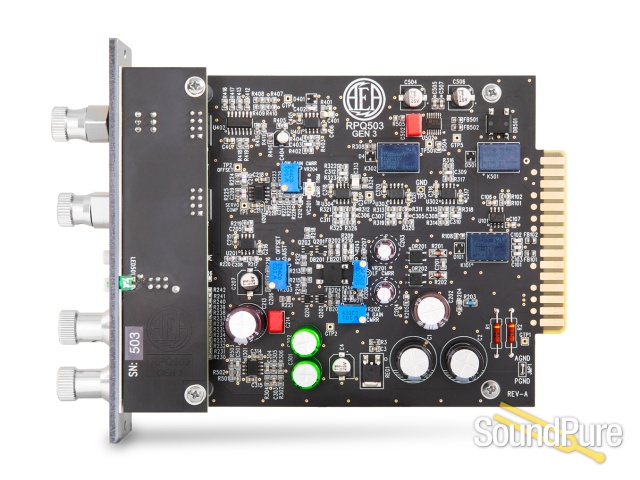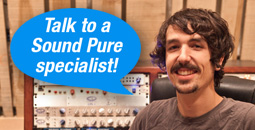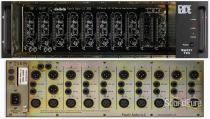-
Call Us Toll Free888-528-9703
-
Local/International (+1)919-682-5552
- Call Us! Toll Free! 888-528-9703
- Local / International (+1) 919-682-5552

$749.00
"Experience the Difference"
 Payments as low as $65/mo.
Payments as low as $65/mo.
Manufacturer's Description from AEA
The RPQ503 is the next evolution in AEA’s trusted lineage of high-impedance, high-gain preamplifiers.
Based on the 3rd Generation circuit design of our celebrated RPQ3, the RPQ503 brings the same rich and natural sound to the 500 Series Format. Featuring a powerful combination of ultra-low noise, low-distortion op-amps, ultra-high 68KΩ input impedance, and 85dB of clean gain, the RPQ503 delivers exceptional clarity and detail. More than just a preamp, the RPQ503 also includes the expanded EQ section of the RPQ3, with boost and cut controls for both low and high end, on custom, compact, dual-concentric potentiometers.
At once open and transparent but equally responsive and dynamic, the RPQ503 is a versatile tool for the front end of any signal path.
Feature set
- 1-Space 500-series preamp
- AEA Gen 3 preamp circuitry
- Ultra-high 68KΩ input impedance (phantom power off)
- 7 to 85 dB of gain
- LF/HF sweepable frequency
- EQ boost/cut, +/-20 dB
- EQ in/out switching; center detents on EQ gain pots
- +48V phantom
- Polarity switch
- Mic/line input switching (line input bypasses mic pre)
- Made in the USA
Expanded EQ Section
The RPQ503 expands on our signature CurveShaperTM circuitry, offering boost and cut curves for both bands of the EQ allowing users to control their sound right at the start of the signal path. With easy-to-understand controls and sweepable frequency knobs, the expanded EQ section of the RPQ503 offers boost and cut options for both lows and highs. Even when boosting aggressively, the RPQ503 remains flatteringly natural. When the EQ IN LED is illuminated, both LF and HF EQs are in the circuit. If you want to use only one band of EQ and not the other, simply turn the gain knob (the front one) of that pot to the center, which is detented.

About Manufacturer
Wes Dooley's longtime passion for audio has infused his company, Audio Engineering Associates (AEA), with a well balanced blend of creativity and technical expertise for forty years. At the core of AEA is a genuine interest in the art and science of audio. From areas as diverse as forensic audio and microphone design, Wes' passion for audio has led him all over the world, from recording experiences in Europe, Africa, and New Zealand, to the courtrooms of Los Angeles as a forensic audio and video expert witness. Such experiences have led Wes to design products which help resolve problems commonly encountered by recording engineers. His portable recording tools including, multi-channel microphone arrays, MS stereo processors, stereo phase displays and very tall microphone stands, have all made on-site recording far more feasible. Despite his contributions to on-location recording, Wes is best known for his pursuit of excellence in ribbon microphone technology. After two decades of representing and servicing the BBC 4038 in the United States, he began to experiment with his own ribbon microphones. During the last decade Wes became aware of the increasing scarcity of R44's and other ribbon microphones. In 1998, responding to this need, Wes re-introduced the 44 much to the thrill of many in the recording industry. Les Paul told Wes that AEA's R44 is his favorite microphone and engineer/producers such as Bruce Swedien, Kevin Bacon, and Shawn Murphy routinely use AEA's R44. Even without such critical acclaim the numbers speak for themselves. Over half of the movies scored in Los Angeles have a 44 somewhere on the scoring stage. Building off of his successful reintroduction of the R44, in 2002 Wes designed and began producing an original ribbon mic, the AEA R84. His groundbreaking work with ribbon microphones helped him to secure the Audio Engineering Society (AES) Silver Medal Award in the fall of 2003. This award, established by the AES in 1971, in honor of audio pioneers Alexander Graham Bell, Emile Berliner, and Thomas A. Edison, is given in recognition of outstanding development or achievement in the field of audio engineering. Wes has also co-authored two AES Journal articles about stereo microphone techniques, chaired workshops on mic techniques and mixing strategies for compatible multiple releases for cinema, broadcast and home video, and has presented section meetings on stereo techniques and forensic audio. He is involved with AES standards work and currently serves on the SC-03-12 Working Group on Forensic Audio and SC-04-04 Working Group on Microphone Measurement and Characterization.
Specifications
|
Max Gain at 1kHz: |
85 dB |
|
EIN (Max Gain 22 Hz to 22 kHz): |
-130 dBu (typical), 40 Ω source unweighted -128 dBu (typical), 150 Ω source unweighted |
|
Frequency Response: |
30 dB gain: (-0.6 dB 10 Hz, -3 dB 160 kHz) 85 dB gain: (-3 dB 10 Hz and 160 kHz) |
|
THD+N: |
0.0018% (1 kHz, 22 Hz-22 kHz @30 dB Gain +4 dBu output) |
|
XLR Output Maximum Level: |
+27 dBu into 600 Ω load |
|
Input Impedance: |
68 kΩ |
|
Input Impedance (P48 Engaged): |
11.3 kΩ |
|
Output Impedance: |
50 Ω |
|
Max Input Signal Level |
+20 dBu (minimum gain) |
|
Mic Gain Control: |
12-position switch from +7 dB to +65 dB |
|
Output Trim: |
Continuously variable from 0 dB to +20 dB |
|
EQ Circuitry: |
First order shelving response 20 dB max boost/cut Low frequency sweep continuously variable 40 Hz to 675 Hz High frequency sweep continuously variable 2 kHz to 28 kHz |
|
Input and Output XLR Polarity: |
Pin 2 high |
|
LED Signal Level Indicators: |
Green LED = -20 dBu; Yellow LED = 0 dBu; Red LED = +20 dBu (clipping +27 dBu) |
|
Dimensions: |
0.125” anodized aluminum front panel measured with knobs and switches: 1.5”W, 6.8”D, 5.2”H (3.8cm x 17.27cm x 3.34cm) |
|
Weight: |
12 oz (~0.338 kg) |





















